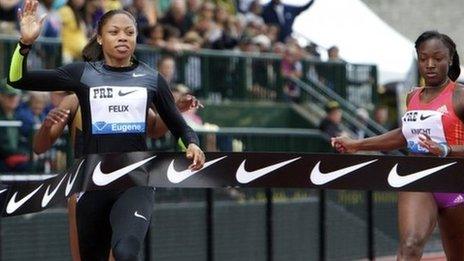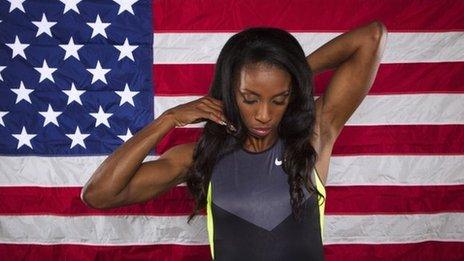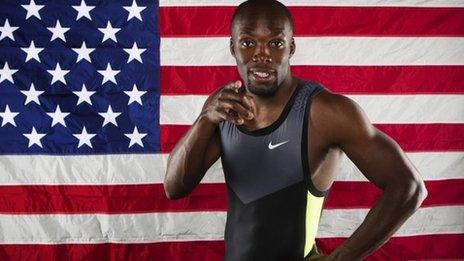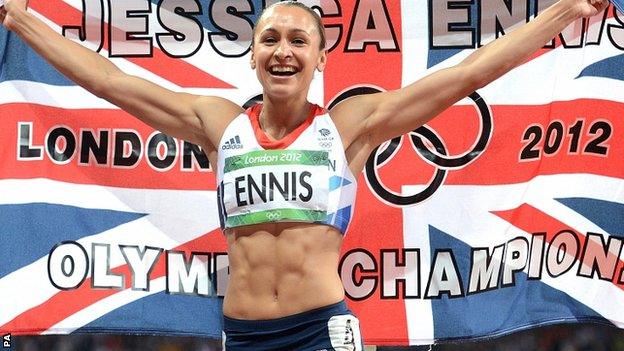London 2012: Diagnosis boost for Sanya Richards-Ross
- Published
Richards-Ross on mystery illness
Five years ago, Sanya Richards-Ross emerged from the US national trials beaten, confused and diagnosed.
The reigning Female World Athlete of the Year, Richards-Ross went to Indianapolis as most experts' first name on the American team sheet for the 2007 World Championships. But the US trials are notoriously tense, and favourites do falter, particularly when they are not in peak condition.
That was certainly the case for Richards-Ross. What was unusual - and frightening for the Jamaican-born sprinter herself - was the nature of her problem.
This was no muscle strain, the world's best 400m runner was covered in skin lesions, her joints ached and the inside of her mouth was so ulcerated that it hurt to drink water. To make matters worse, a deep fatigue set in as she progressed from the qualifying round to semi-final to final.
That she managed to come fourth, missing qualification for the individual event by one place, is a testament to her consistency over the one-lap distance. But Richards-Ross could not wait to get out of the trials and find out why she was afflicted with these mysterious symptoms.
A new doctor provided the answer, treatment started and things improved. As a result, she was able to take her place in the 4x400m team at the Worlds, adding a second relay gold to the one claimed as an 18-year-old in 2003.
Richards-Ross was running fast again but she was now officially a Behcets syndrome sufferer.
A rare, chronic disease that involves the inflammation of blood vessels all over the body, Behcets can cause serious skin problems, arthritis and meningitis: it can also affect memory, speech and movement.
Richards-Ross never made much of her struggles with it - she wore long sleeves and body make-up when the lesions appeared - but she would occasionally be too tired to train.
Despite this, she did not want to use the condition as an excuse for her failures to turn season-long domination of the 400m into individual gold medals at the year's biggest championships: those 2007 Worlds, the 2008 Olympics and again at the Worlds in 2011.
"As an athlete you never want to blame anything other than saying you didn't execute well on that day," the 27-year-old told me in Dallas last month.
"But if there was ever a time when it affected my performance it was at (the trials) in 2007, I just didn't feel right. I got worse from round to round and I left straight after to see a doctor because I felt so bad. That's when I got diagnosed.
"But after that I felt I had it pretty much under control. There might have been a few times when I couldn't prepare as well as I might have but for the most part it was just not executing on the day, the pressure, or wanting it too badly. I blame those things more than the disease."
There was one other reason why Richards-Ross was reluctant to blame Behcets: she did not believe she really had it.
As a leading light in track and field, and being married to NFL star Aaron Ross, Richards-Ross was arguably the most famous American afflicted with the disease, so she was often approached by other sufferers.
"A lot of people with Behcets reached out to me, and when we talked about our symptoms I felt I didn't have what they had," she explained.
"And the more research I did, the more I thought 'this can't be right, it doesn't fit'.
"So I kept searching until this year I started working with a new doctor, and he doesn't think I have it.
"He thinks it's a treatable skin disease and I've been doing a lot better. I don't get the fatigue or joint pains nearly as much and the lesions and ulcers are better too.
"I'm excited that it's behind me, but it was definitely a tough time."
To say Richards-Ross is "doing a lot better" on the track is hard to measure until we see how she deals with the extra demands that a major championship places on body and mind. The 27-year-old has been churning out world-leading times since 2005 but only had one individual gold medal to show for it - the 2009 Worlds - before this season.
And while few current athletes have won so many one-off races on the annual circuit, it is defeats to the likes of Bahamas' Tonique Williams-Darling at the 2005 Worlds,, external Britain's Christine Ohuruogu at the 2008 Olympics, external and last year's seventh-place finish in Daegu that stand out.
This year's Richards-Ross does look different, though.
Once again, she tops the time charts for 400m, but she is also quickest over 200m, setting a personal best of 22.09 in New York earlier this month.
And she added another individual gold medal to her tally in March, winning the 400m at the World Indoors. This revealed a new approach to a championship season, as she had not even run an indoor 400m for the previous six campaigns.
So, one of sport's most dominant athletes looks set, once more, to translate her undeniable class into something truly memorable. She will return to the US national trials on Sunday, once again looking to establish herself as the best in the world this summer. This time, however, she is healthy.
The women's 400m race at London 2012 could be the most delayed coronation in recent track and field history.
- Published14 June 2012

- Published17 May 2012

- Published17 May 2012

- Published10 September 2015
